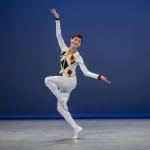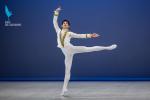On 1st and 2nd February 2013, I managed to realise one of my old dreams.
Ever since I became serious about ballet, I dreamed of going to Lausanne to take part in this prestigious competition. As you can imagine, this did not come true as I was neither a genius nor born into a very rich family. So my dream of “going to take part in Prix de Lausanne” changed into “going to see Prix de Lausanne” fairly early on.
This year, one of my dancers who is from Lausanne offered me accommodation during the weekend of Prix de Lausanne finals!
The Prix de Lausanne started back in 1973 and is a competition giving young non-professional dancers, aged between fifteen and eighteen years, the chance to win a scholarship to study at any ballet school they choose for a year. For those young dancers whose country does not have a state ballet school, this is a fantastic opportunity. There have been many wonderful dancers who won scholarships in this competition and went on to become world- leading principal dancers: Miyako Yoshida, Tetsuya Kumakawa, Carlos Acosta, Darcey Bussell, Alina Cojocaru and many more.
The competition takes place over six days at the Théâtre de Beaulieu and during the first four days the candidates are given opportunities to take classes by world- renowned teachers and receive coaching from leading coaches. The jury observe the course of classes and it counts towards their final scores.
These days candidates are to apply by submitting an audition DVD. Around 80 of the applicants are invited to take part in this week long event and of those approximately 20 dancers will be chosen to participate in the final.
Candidates are to dance a solo from the classical repertoire and a contemporary solo (they have to choose one each from lists of choices).
This year, there were seventy-five semi-finalists all together: thirty-five 15-16 year-olds and forty 17-18 year-olds. Out of the seventy-five, twenty made it to the final.
There were sixteen boys and four girls, which is quite an unusual ratio. It is good to see so many strong boys. The first prize went to a boy named Adhonay Silva from Brazil. He is only fifteen years old and yet his technique is already very well established and secure. And yet I could see that he made an improvement since the semi final. He was very charming and brought smiles to my face. He also had the rare quality to make what he did look easy. He was a worthy winner and I do hope to see him one day on a world stage. He also won the audience prize. Audience members are given a ballot paper and were asked to vote whom they liked best. I am not at all surprised he won this prize as well.
In total eight scholarship prizes were given and although all eight winners are given equally full scholarship to a ballet school or company of their choice, they are given in reverse order and the last one, the one to win the first scholarship prize is considered to be the best one in the competition.
Aside from Adhonay Silva, there were a few that made an impression on me.
Li Wentao, a seventeen-year-old from China who won the second prize, danced the Prince’s solo from the Sleeping Beauty and I was very impressed by his musicality. It is a very musically difficult solo but he performed it very confidently and smoothly.
The eighteen-year-old Masaya Yamamoto (third place) was a very light and precise dancer. His contemporary was also excellent. I could watch him knowing that he wasn’t going to fall over.
Gong Zunyuan, seventeen, who did not manage to get a scholarship was very light and his fantastic jumps excited the audience. His pirouettes needed a little more control, but it would be interesting to see how he does from here. His contemporary was also very good.
One disappointment was the fact that Kaho Yanagisawa, fifteen, did not get a scholarship. She had such strong technique that she danced so effortlessly. She also had lovely presence on stage. She made an impressively huge improvement in her contemporary between the semi-final and the final. I was convinced that she would at least receive the Prix Niveau Professionnel, but I had not realised that it was abolished in 1998. This was a cash prize which used to go to the candidates who were considered to have reached the level of professional dancers. I really hope that some great opportunity will open up for her in the near future.
There are several prizes the Prix de Lausanne committee abolished over the years. The aforementioned Prix Niveau Professionnel is one. The Médaille d’Or was last awarded in 1995 and was abolished in 2001. This was a very special prize that was not given out every year and was only awarded to exceptional talent: Tetsuya Kumakawa and Carlos Acosta are both past winners. The Prix Espèces was a cash prize which used to be given if a student of a state ballet school won the competition. The Prix Espoir was the scholarship prize for under fifteens but was abolished in 2002. The Prix de la meilleure chorégraphie personnel (changed to Prix d’encouragement à la chorégraphi in 1983) was given to those who choreographed their own free variation (this was abolished in 2005 to enable the judges to assess the dancers’ abilities without being confused by various choreography).
I usually do not like competitions for ballet. I feel that ballet is an art form and yet competitions make dancers want to jump higher, lift their legs higher, and turn more times. Although I love seeing people with strong technique, I feel very strongly that in ballet technique should never be the aim of the performance. Truly wonderful dancers do use their strong technique, but make it look effortless and use it to express something more. At the Prix de Lausanne, the judges look for potential. In addition to the competitive performances, they watch classes over the first few days and take what they see there into account. Also, for those who did not make it through to the final round, there is a chance to have a special class and talk to the directors of various companies and schools and they may be fortunate enough to be offered more chances. Most of the candidates say that they have learned so much through the course of a week and they all seem to enjoy themselves and make friends with young dancers from other countries. I admire all the people who make this event happen and hope it will remain the inspiration to young generations of dancers for a long time to come.
I have encountered one big problem after having been to see the semi-final and final of the Prix de Lausanne. Now that one dream has come true, a new one has emerged… I would so much love to go and see the course of the entire week!







